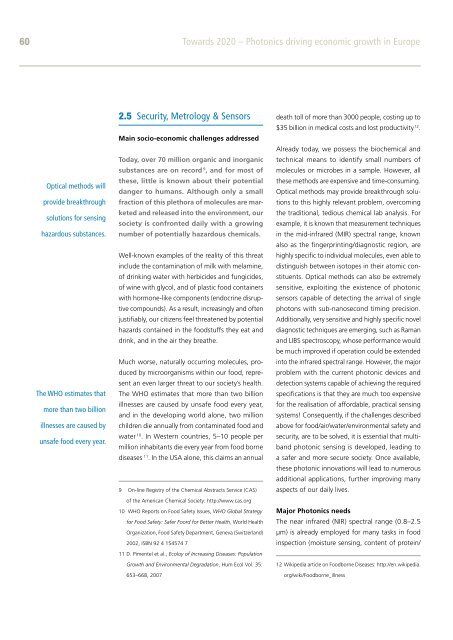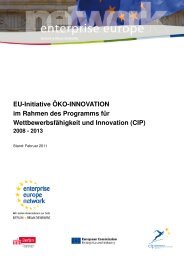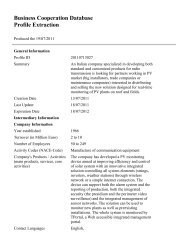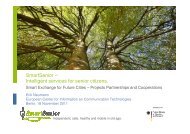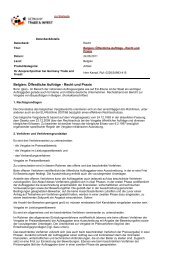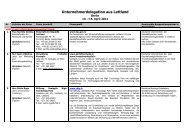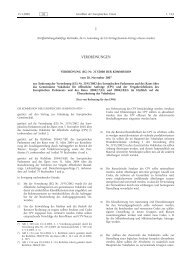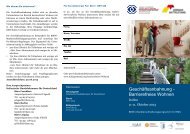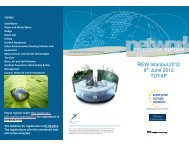Photonics Driving Economic Growth in Europe - Photonics21
Photonics Driving Economic Growth in Europe - Photonics21
Photonics Driving Economic Growth in Europe - Photonics21
Create successful ePaper yourself
Turn your PDF publications into a flip-book with our unique Google optimized e-Paper software.
60 Towards 2020 – <strong>Photonics</strong> driv<strong>in</strong>g economic growth <strong>in</strong> <strong>Europe</strong><br />
Optical methods will<br />
provide breakthrough<br />
solutions for sens<strong>in</strong>g<br />
hazardous substances.<br />
The WHO estimates that<br />
more than two billion<br />
illnesses are caused by<br />
unsafe food every year.<br />
2.5 Security, Metrology & Sensors<br />
Ma<strong>in</strong> socio-economic challenges addressed<br />
Today, over 70 million organic and <strong>in</strong>organic<br />
substances are on record 9 , and for most of<br />
these, little is known about their potential<br />
danger to humans. Although only a small<br />
fraction of this plethora of molecules are mar-<br />
keted and released <strong>in</strong>to the environment, our<br />
society is confronted daily with a grow<strong>in</strong>g<br />
number of potentially hazardous chemicals.<br />
Well-known examples of the reality of this threat<br />
<strong>in</strong>clude the contam<strong>in</strong>ation of milk with melam<strong>in</strong>e,<br />
of dr<strong>in</strong>k<strong>in</strong>g water with herbicides and fungicides,<br />
of w<strong>in</strong>e with glycol, and of plastic food conta<strong>in</strong>ers<br />
with hormone-like components (endocr<strong>in</strong>e disrup-<br />
tive compounds). As a result, <strong>in</strong>creas<strong>in</strong>gly and often<br />
justifiably, our citizens feel threatened by potential<br />
hazards conta<strong>in</strong>ed <strong>in</strong> the foodstuffs they eat and<br />
dr<strong>in</strong>k, and <strong>in</strong> the air they breathe.<br />
Much worse, naturally occurr<strong>in</strong>g molecules, produced<br />
by microorganisms with<strong>in</strong> our food, represent<br />
an even larger threat to our society’s health.<br />
The WHO estimates that more than two billion<br />
illnesses are caused by unsafe food every year,<br />
and <strong>in</strong> the develop<strong>in</strong>g world alone, two million<br />
children die annually from contam<strong>in</strong>ated food and<br />
water 810 . In Western countries, 5–10 people per<br />
million <strong>in</strong>habitants die every year from food borne<br />
diseases 911 . In the USA alone, this claims an annual<br />
9 On-l<strong>in</strong>e Registry of the Chemical Abstracts Service (CAS)<br />
of the American Chemical Society: http://www.cas.org<br />
10 WHO Reports on Food Safety Issues, WHO Global Strategy<br />
for Food Safety: Safer Foord for Better Health, World Health<br />
Organization, Food Safety Department, Geneva (Switzerland)<br />
2002, ISBN 92 4 154574 7<br />
11 D. Pimentel et al., Ecoloy of Increas<strong>in</strong>g Diseases: Population<br />
<strong>Growth</strong> and Environmental Degradation, Hum Ecol Vol. 35:<br />
653–668, 2007<br />
death toll of more than 3000 people, cost<strong>in</strong>g up to<br />
$35 billion <strong>in</strong> medical costs and lost productivity 1012 .<br />
Already today, we possess the biochemical and<br />
technical means to identify small numbers of<br />
molecules or microbes <strong>in</strong> a sample. However, all<br />
these methods are expensive and time-consum<strong>in</strong>g.<br />
Optical methods may provide breakthrough solutions<br />
to this highly relevant problem, overcom<strong>in</strong>g<br />
the traditional, tedious chemical lab analysis. For<br />
example, it is known that measurement techniques<br />
<strong>in</strong> the mid-<strong>in</strong>frared (MIR) spectral range, known<br />
also as the f<strong>in</strong>gerpr<strong>in</strong>t<strong>in</strong>g/diagnostic region, are<br />
highly specific to <strong>in</strong>dividual molecules, even able to<br />
dist<strong>in</strong>guish between isotopes <strong>in</strong> their atomic constituents.<br />
Optical methods can also be extremely<br />
sensitive, exploit<strong>in</strong>g the existence of photonic<br />
sensors capable of detect<strong>in</strong>g the arrival of s<strong>in</strong>gle<br />
photons with sub-nanosecond tim<strong>in</strong>g precision.<br />
Additionally, very sensitive and highly specific novel<br />
diagnostic techniques are emerg<strong>in</strong>g, such as Raman<br />
and LIBS spectroscopy, whose performance would<br />
be much improved if operation could be extended<br />
<strong>in</strong>to the <strong>in</strong>frared spectral range. However, the major<br />
problem with the current photonic devices and<br />
detection systems capable of achiev<strong>in</strong>g the required<br />
specifications is that they are much too expensive<br />
for the realisation of affordable, practical sens<strong>in</strong>g<br />
systems! Consequently, if the challenges described<br />
above for food/air/water/environmental safety and<br />
security, are to be solved, it is essential that multiband<br />
photonic sens<strong>in</strong>g is developed, lead<strong>in</strong>g to<br />
a safer and more secure society. Once available,<br />
these photonic <strong>in</strong>novations will lead to numerous<br />
additional applications, further improv<strong>in</strong>g many<br />
aspects of our daily lives.<br />
Major <strong>Photonics</strong> needs<br />
The near <strong>in</strong>frared (NIR) spectral range (0.8–2.5<br />
µm) is already employed for many tasks <strong>in</strong> food<br />
<strong>in</strong>spection (moisture sens<strong>in</strong>g, content of prote<strong>in</strong>/<br />
12 Wikipedia article on Foodborne Diseases: http://en.wikipedia.<br />
org/wiki/Foodborne_illness


